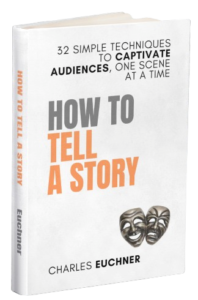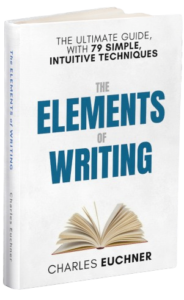Have you ever gone back to an old school? Driven past an old Little League field where you used to play? Or stopped by an old mall, where you once did all your shopping, and found it cluttered with Dollar Stores and fast-fashion outlets?
 The experience is deflating. In your own mind, you imagined these places more exciting. One day, long ago, they represented promise and growth. But now, visiting the old dorm or ballfield, it’s a letdown.
The experience is deflating. In your own mind, you imagined these places more exciting. One day, long ago, they represented promise and growth. But now, visiting the old dorm or ballfield, it’s a letdown.
Is that all there is?
That’s the feeling I got recently when I was sorting through old books and found Talk Like TED–a primer for wannabe spellbinders looking to enlighten the world with their mix of personal testimony and cutting-edge research.
Once upon a time, TED regularly delivered on its slogan: “ideas worth sharing.” My favorite was Ken Robinson‘s “Do Schools Kill Creativity?” Al Gore did a great talk on the climate crisis. Jane McGonigal explored how gaming can make a better world. Simon Sinek explained the importance of asking why. Brené Brown won fame with her talk on vulnerability. Amy Cuddy modeled how to use the Wonder Woman pose to supercharge your mind, body, and emotions. These, by the way, are all still among the top talks, a decade or more after their delivery.
TED, which launched in 2006, is still alive, with 27 million subscribers on its YouTube page. But somewhere along the line, it lost its mojo. Now, it’s a chore to find the mind-altering presentation among the 4,700 videos. With all the regional offshoots with TEDx, topics and speakers seem ordinary, sometimes even tedious.
And curious people have new options. Podcasts, from The Huberman Lab to The Joe Rogan Experience to Call Her Daddy offer sharper points through intense conversation. You can tell these people care about what they’re doing. They go deep on compelling topics.
 But the problem is more fundamental: The TED formula got flat and predictable. As obscure speakers marched to the big red dot, armed with their tales of exploration and challenge, they seemed to follow a script rather than sharing their passions
But the problem is more fundamental: The TED formula got flat and predictable. As obscure speakers marched to the big red dot, armed with their tales of exploration and challenge, they seemed to follow a script rather than sharing their passions
TED succeeded, at first, because its presentations with carefully curated, with strict time limits, an understanding of narrative, an effective interplay of words and images. Plus, presenters practiced their talks endlessly. When they got on stage, they were ready to rock.
More important, the speakers had a passion and an urgency.
About that book, Talk Like TED, a 2014 bestseller by Carmine Gallo. Consider its nine “secrets” for public speaking:
- Unleash the Master Within (huh?)
- Master the Art of Storytelling (duh)
- Have a Conversation (duh)
- Teach Me Something New (you don’t say!)
- Deliver Jaw-Dropping Moments (really?)
- Lighten Up (always?)
- Stick to the 18-Minute Rule (how about one minute to start?)
- Paint a Mental Picture with Multisenstory Experiences (natch)
- Stay in Your Lane (OK, but even if I really need to tell you something else?)
All good advice, I suppose. It can be useful to know Colin Powell’s body language: Both hands spread shoulder-length apart … Makes circular movement … Right hand extends and clasps into a fist ,… Points toward himself …
And, yes, it’s helpful to think of stories as “just data with a soul” and to give the reader “one character I can root for.”
After this book came out, I watched as TEDster after TEDster followed Gallo’s advice. Problem was, the talks started to sound like stale paint-by-numbers presentations. The speakers weren’t brimming with excitement: Hey, there’s something I gotta tell ya. As the years went by, TEDsters spoke self-consciously rather than exuberantly or intensely.
To communicate well, sure, it makes sense to “Have a Conversation” and “Become a Master Storyteller.” Sure, follow certain do’s and don’ts. But before you do that, you need to care intensely about the topic.
Years ago, I sat in on the Dale Carnegie Training program in New Haven. Every week, participants delivered one-minute talks–without much preparation, without notes, but speaking from the heart. No one tried to out-perform Ken Robinson or Brené Brown. They just spoke about something that mattered to them.
The format was simple:
- “So there I was…”
- “And then, … And then, … And then, …”
- “Until finally … when I realized …”
These talks were often emotional and revealing. Speakers described their fears, regrets, crazy moments, scary moments. They took us on a meaningful journey. At the end, we cared.
As you craft your stories–whether you’re in business, school, journalism, publishing, or just posting on social media–start there. Yes, you can and should use dozens of specific techniques to craft your story.
But the real energy a presentation comes not from a list of nine “secrets.” It comes from something you desperately want to share with someone (RIP, Ken) and willing to be vulnerable about (h/t, Brené). Find a puzzle you desperately want to solve (thanks, Simon and Jane). If you can, make it physical (props, Amy). If it’s socially important, great (thanks, Al).
The key word, I think, is authenticity.With it, you have a chance. Without it, you’re doomed.
I think TED has lost this basic truth. That’s OK. It was a nice run. Too bad it got so bland and predictable.
That’s my personal TED talk. (Bowing, waving.) Thanks very much.
TED’s Greatest Hits (IMHO)
Ken Robinson on creativity (pay special attention to the story beginning at 15:08)
Al Gore on the climate crisis
Jane McGonigal on creativity
Simon Sinek on the power of “why”
Brené Brown on vulnerability
Amy Cuddy on the mind/body/emotion nexus

